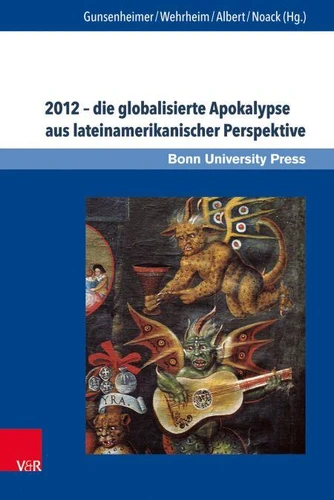2012 – die globalisierte Apokalypse aus lateinamerikanischer Perspektive
Par : , , ,Formats :
Disponible dans votre compte client Decitre ou Furet du Nord dès validation de votre commande. Le format PDF est :
- Compatible avec une lecture sur My Vivlio (smartphone, tablette, ordinateur)
- Compatible avec une lecture sur liseuses Vivlio
- Pour les liseuses autres que Vivlio, vous devez utiliser le logiciel Adobe Digital Edition. Non compatible avec la lecture sur les liseuses Kindle, Remarkable et Sony
 , qui est-ce ?
, qui est-ce ?Notre partenaire de plateforme de lecture numérique où vous retrouverez l'ensemble de vos ebooks gratuitement
Pour en savoir plus sur nos ebooks, consultez notre aide en ligne ici
- Nombre de pages204
- FormatPDF
- ISBN978-3-8470-0685-5
- EAN9783847006855
- Date de parution11/09/2017
- Protection num.pas de protection
- Taille6 Mo
- Infos supplémentairespdf
- ÉditeurV&R Unipress
Résumé
2012 erlebte die Welt einen spektakulären Medienhype um einen angeblich im Maya-Kalender vorausgesagten Weltuntergang. Was ist in den Maya-Hieroglypheninschriften diesbezüglich tatsächlich vermerkt? Welchen historischen Hintergrund haben europäische Apokalypse-Vorstellungen? Dem geht der Band in Studien aus verschiedenen Disziplinen nach. Darüber hinaus beschäftigen sich die Beiträger mit den Apokalypse-Vorstellungen ausgewählter amerindischer Gesellschaften.
Sie beleuchten weiter, wie diese Apokalypse in der modernen mexikanischen Literatur als Metapher aufgegriffen wird. Ein Interview mit dem Maya-Experten Nikolai Grube über die Auswirkungen des Jahres 2012 auf die Maya-Forschung beschließt den Band. In 2012, the world experienced a spectacular media based hype about the reputed end of the world according to the end of the Maya calendar. The volume at hand combines studies of different disciplines which explore the question, what Maya hieroglyphic inscriptions really tell us about the "end of the world" and what of our apocalyptic visions are based on our own historic Jewish-Christian background.
Further contributors in this volume discuss apocalyptic ideas of selected Amerindian societies from the colonial past up to the present. They also reflect how those apocalyptic visions are taken up again as metaphors in modern Mexican literature. The volume is closed by an interview on the effects of "2012" on Maya research with expert Nikolai Grube.
Sie beleuchten weiter, wie diese Apokalypse in der modernen mexikanischen Literatur als Metapher aufgegriffen wird. Ein Interview mit dem Maya-Experten Nikolai Grube über die Auswirkungen des Jahres 2012 auf die Maya-Forschung beschließt den Band. In 2012, the world experienced a spectacular media based hype about the reputed end of the world according to the end of the Maya calendar. The volume at hand combines studies of different disciplines which explore the question, what Maya hieroglyphic inscriptions really tell us about the "end of the world" and what of our apocalyptic visions are based on our own historic Jewish-Christian background.
Further contributors in this volume discuss apocalyptic ideas of selected Amerindian societies from the colonial past up to the present. They also reflect how those apocalyptic visions are taken up again as metaphors in modern Mexican literature. The volume is closed by an interview on the effects of "2012" on Maya research with expert Nikolai Grube.
2012 erlebte die Welt einen spektakulären Medienhype um einen angeblich im Maya-Kalender vorausgesagten Weltuntergang. Was ist in den Maya-Hieroglypheninschriften diesbezüglich tatsächlich vermerkt? Welchen historischen Hintergrund haben europäische Apokalypse-Vorstellungen? Dem geht der Band in Studien aus verschiedenen Disziplinen nach. Darüber hinaus beschäftigen sich die Beiträger mit den Apokalypse-Vorstellungen ausgewählter amerindischer Gesellschaften.
Sie beleuchten weiter, wie diese Apokalypse in der modernen mexikanischen Literatur als Metapher aufgegriffen wird. Ein Interview mit dem Maya-Experten Nikolai Grube über die Auswirkungen des Jahres 2012 auf die Maya-Forschung beschließt den Band. In 2012, the world experienced a spectacular media based hype about the reputed end of the world according to the end of the Maya calendar. The volume at hand combines studies of different disciplines which explore the question, what Maya hieroglyphic inscriptions really tell us about the "end of the world" and what of our apocalyptic visions are based on our own historic Jewish-Christian background.
Further contributors in this volume discuss apocalyptic ideas of selected Amerindian societies from the colonial past up to the present. They also reflect how those apocalyptic visions are taken up again as metaphors in modern Mexican literature. The volume is closed by an interview on the effects of "2012" on Maya research with expert Nikolai Grube.
Sie beleuchten weiter, wie diese Apokalypse in der modernen mexikanischen Literatur als Metapher aufgegriffen wird. Ein Interview mit dem Maya-Experten Nikolai Grube über die Auswirkungen des Jahres 2012 auf die Maya-Forschung beschließt den Band. In 2012, the world experienced a spectacular media based hype about the reputed end of the world according to the end of the Maya calendar. The volume at hand combines studies of different disciplines which explore the question, what Maya hieroglyphic inscriptions really tell us about the "end of the world" and what of our apocalyptic visions are based on our own historic Jewish-Christian background.
Further contributors in this volume discuss apocalyptic ideas of selected Amerindian societies from the colonial past up to the present. They also reflect how those apocalyptic visions are taken up again as metaphors in modern Mexican literature. The volume is closed by an interview on the effects of "2012" on Maya research with expert Nikolai Grube.




